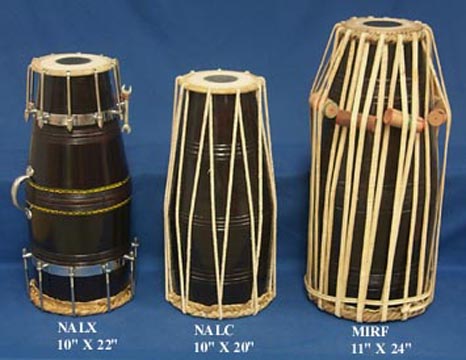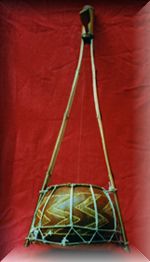Bangladesh is a melting pot of races.
She,
therefore, has a mixed culture. Her deep rooted heritage is amply
reflected in
her architecture, literature, dance, drama, music and painting.
Bangladeshi culture is influenced by
three great religions- Hinduism, Buddhism and Islam in successive order,
with
Islam having the most pervading and lasting impact. Like a colorful
montage, the
cultural tradition of the country is a happy blending of many variants,
unique
in diversity but in essence greatly symmetrical.
Festivals:
A series of festivals
varying from race to race
are observed here. Some of the Muslim rites are Eid-e-Miladunnabi,
Eid-ul-Fitr, Eid-ul-Azha, Muharram
etc. Hindus observe Durga Puja, Saraswati Puja, Kali Puja and many other
pujas.
Christmas ( popularly called Baradin in Bangla ) is observed by
Christians.
Also there
are some common festivities, which are observed countrywide by people
irrespective of races.
Pahela Baishakh
(the first day of Bangla year) is such a festival. National
festivals are Independence
Day (26th March), 21st February
(the
National Mourning Day and World Mother Language Day), The Victory Day
(16th
December), Rabindra &
Nazrul Jayanti etc.
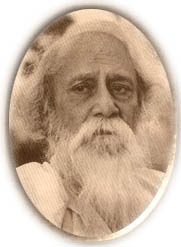 |
| Rabindranath Tagore |
Literature:
Bangalees have a rich literary heritage. The earliest available
specimen of
Bengali literature is about a thousand years old. During the mediaeval
period.
Bengali Literature developed considerably with the patronage of Muslim
rulers.
Chandi Das, Daulat Kazi and Alaol are some of the famous poets of the
period.
The era of modern Bengali Literature
began in the late nineteenth century
Rabindranath Tagore, the Nobel Laureate is a vital part of
Bangalee culture. Kazi
Nazrul Islam,
Michael Madhusudan
Datta. Sarat
Chandra Chattopadhaya, Bankim Chandra
Chattopadhaya, Mir Mosharraf Hossain and
Kazi Ahdul Wadud are the pioneers of modern Bengali Literature.
Music:
The
traditional music in Bangladesh shares the perspectives of that of the
Indian
sub-continent. Music in
Bangladesh can be divided into three distinct categories -classical,
folk and
modern. The classical music, both vocal and instrumental is rooted in
the remote
past of the sub-continent. Ustad Alauddin Khan and Ustad Ayet Ali Khan
are two
names in classical instrumental music who are internationally known.
The store of folk song abounds in spiritual
lyrics of
Lalan Shah, Hasan Raja, Romesh Shill and many anonymous lyricists.
Bangla
music arena is enriched with Jari, Shari, Bhatiali, Murshidi and other
types of folk
songs. Rabindra Sangeet and Nazrul Sangeet are Bangalees'
precious heritage. Modern music is also practiced widely. Contemporary
patterns have more inclinations to west. Pop song
and band groups are also coming up mainly in Dhaka
City.
Musical Instruments
Bangladesh has a good number of musical
instruments
originally
of her own. Originally country musical instruments include, Banshi
(bamboo
flute), Dhole (wooden drums), Ektara (a single stringed instrument),
Dotara (a
four stringed instrument), Mandira (a pair of metal bawls used as rhythm
instrument), Khanjani, Sharinda etc. Now-a-days western instruments such
as
Guitar, Drums, Saxophone, Synthesizer etc. are being used alongside
country instruments.
|
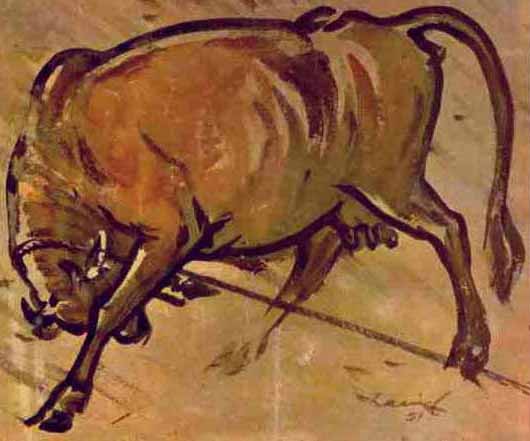 |
|
|
Zainul Abedin's
painting called 'The Rebel
Cow'
|
|
Painting:
There is a rich
tradition of modern painting which was
pioneered by Zainul
Abedin, Kamrul
Hassan, Anwarul Haque, Shafiuddin Ahmed
and S.
M. Sultan. Zainul
Abedin earned
international fame for his sketches on famine of 1943 in
Bangladesh. Other famous artists of Bangladesh are Abdur
Razzak, Qayyum
Chowdhury, Murtaza
Baseer, Aminul
Islam, Debdas
Chakraborty, Kazi
Abdul Baset, Syed
Jahangir, and Mohammad
Kibria
Drama:
Drama in Bangladesh
has an old tradition and is very popular. In
Dhaka more than a dozen theater groups
have been regularly staging
locally written plays as well as those adopted
from famous writers, mainly of European
origin. Popular
theatre groups are Dhaka Theatre, Nagarik Nattya Sampraday and Theatre.
In Dhaka, Baily Road area is known as 'Natak Para'
where drama shows are regularly held. Public Library Auditorium and
Museum Auditorium
are famous for holding cultural shows. Dhaka University area is a
pivotal part
of cultural activities.
Dance:
|
 |
|
|
Folk
Dance
|
|
Classical forms of the sub-continent
predominate in Bangladeshi dance. The folk, tribal and Middle Eastern
traits are
also common. Among the tribal dances, particularly popular are
Monipuri and
Santal. Rural girls are in the habit of dancing that does
not
require any grammar or regulations. Bangla songs like jari and shari are
presented
accompanied with dance of both male and female performers.
Jatra:
Jatra(Folk Drama) is another vital chapter of Bangalee
culture. It depicts mythological episodes of love and tragedy.
Legendary plays of
heroism are also popular, particularly in
the rural areas. In near past jatra was the
biggest entertainment means for the rural Bangalees and in that sense
for 80% of
the population since the same percentage of the population lived in
rural
Bangladesh. Now-a-days jatra has been placed in the back seat in the
entertainment era. Gradually western culture is occupying the place of
traditional culture like jatra.
Traditional
Transportation Means:
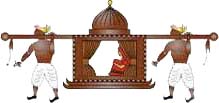 |
Palki
|
There are some transportation means that
are parts of culture of Bangladesh. In rural areas bullock carts,
buffalo carts
and tomtoms (horse carts) are commonly used. In old Dhaka once tomtom
was a common vehicle and still it is found, though rare. Bicycles are
used
both in rural and urban areas. Palki (a box-like vehicle carried
on
shoulders by six men) is a wedding transportation means. Brides are
carried to
the bridegrooms' places by Palki. Being a land crisscrossed by
rivers,
Bangladesh has a wide-ranged tradition of ferry transport. Wooden boat
popularly
called nawka is a vital means of rural communication. Rickshaw is
a very common
vehicle to Bangladeshis.
Clothing:
Bangladeshi women habitually wear Sarees.
Jamdani was once world famous for it's most
artistic and expensive ornamental
fabric. Moslin, a fine and artistic type of cloth was well-known
worldwide.
Naksi Kantha, embroidered quilted patchwork cloth produced by the
village women,
is still familiar in villages and towns simultaneously. A common
hairstyle is Beni
(twisted bun) that Bangalee women are fond of. Traditionally males wear
Panjabis,
Fatuas and Pajamas. Hindus wear Dhuty for religious purposes. Now-a-days
common dresses of males are shirts and pants.
Government and non-government organizations
like
Bangla Academy, Nazrul
Institute, Bangladesh Shilpakala
Academy, Fine arts Institute, Chhayanat etc. play significant role
to flourish
Bangladeshi art and culture providing encouragement
in music, drama, dance, recitation, art etc. Many
other cultural organizations are also popularizing
Bangladeshi art
and culture.
Music,
dance, drama and film
"Amar Shonar Bangla, Ami Tomayee Valobashi..." Music and dance style
of Bangladesh may be divided into three categories, namely, the
classical, folk and the modern. The classical style has been influenced
by other prevalent classical forms of music and dances of the Indian subcontinent, and accordingly show some
influences dance forms like Bharata Natyam and Kuchipudi.
The folk and tribal music and dance forms of Bangladesh are of
indigenous origin and rooted to the soil of Bangladesh. Several dancing
styles in vogue in the north-eastern part of the Indian subcontinent,
like Monipuri and Santal dances, are also practiced in Bangladesh, but
Bangladesh has developed its own distinct dancing styles, for example Nitoshilpi.
Bangladesh has a rich tradition of folk songs, with lyrics rooted into vibrant
tradition and spirituality, mysticism
and devotion.
Such folk songs also revolve round several other themes, including love
themes.
Most prevalent of folk songs and music traditions include Bhatiali,
Baul, Marfati, Murshidi and Bhawaiya.
Lyricists
like Lalon
Shah, Hason Raja, Kangal Harinath, Romesh Shill, Abbas
Uddin and many unknown anonymous lyrists have enriched the
tradition of folk songs of Bangladesh.
In relatively modern context, Rabindra Sangeet and Nazrul
geeti form precious cultural heritage of Bangladesh. In recent time,
western influences have given rise to several quality rock bands,
particularly in urban centers like Dhaka.
Several musical instruments, some of them of indigenous origin, are
used in Bangladesh, and major musical instruments used are bamboo flute
(banshi), drums (dole), a single stringed instrument named ektara, a
four stringed instrument called dotara, a
pair of metal bawls used for rhythm effect called mandira.
Currently, several musical instruments of western origin like guitar, drums, and saxophone
are also used, sometimes alongside the traditional instruments.
Festivals and
celebrations
Festivals and celebrations are integral part of the culture of
Bangladesh. Prominent and widely celebrated festivals are Pohela Baishakh, Independence day,
National Mourning Day, Eid-ul-Fitr,
Eid-ul-Azha, Muharram, Durga puja, and Language Movement Day.
Eid ul-Fitr
Main article: Eid
ul-Fitr
As the most important religious festival for the majority Muslims,
the celebration of Eid ul-Fitr has become a part of the culture of
Bangladesh. The government of Bangladesh declares holiday for three days
on Eid-ul Fitar. People living in towns having their families or
parents in villages go to their country homes to meet relatives and
celebrate the festival together. All outgoing public transport from the
major cities become highly crowded and in many cases the fares tend to
rise in spite of government restrictions.
Adult Muslim males in Bangladesh assemble at the Eid Ghah for prayer in
the morning of the Eid day
On Eid day, Eid prayers are held all over the country, in
open areas like fields or else inside mosques. In Dhaka, the largest Eid
prayer is held at the national Eidgah. All major mosques including the Baitul Mukarram also holds prayers. The biggest
congregation of Bangladesh is held at Sholakia in Kishoreganj, where about half a million
people join the Eid prayer.[1]
After the Eid prayers, people return home, visit each other's home and
eat sweet dishes called shirni. Throughout the day gentlemen
embrace each other. It is also customary for junior members of the
society to touch the feet of the seniors, and seniors returning
blessings (sometimes with a small sum of money as a gift).
In the rural areas Eid festival is observed with great fanfare. In
some areas Eid fares are arranged. Different types of games including
boat race, kabbadi, other traditional
Bangladeshi games as well as modern games like football and cricket are
played on this occasion.
In urban areas people play music, visit each other's houses and eat
special food. Watching movies and television programs has also become an
integral part of Eid celebration in urban areas. All local TV channels
air special program for several days for this occasion.
Eid ul-Adha
Main article: Eid ul-Adha
The celebration of Eid ul-Adha is similar to Eid ul-Fitar in many
ways. The only big difference is the Qurbani or sacrifice of
domestic animals on Eid ul-Adha. Numerous temporary marketplaces of
different sizes called Haat operate in the big cities for sale of
Qurbani animals (usually cows and goats).
In the morning on the Eid day, immediately after the prayer, those
who can afford to slaughter their animal of choice. Less affluent people
also take part in the festivity by visiting houses of the affluent who
are taking part in qurbani. After the qurbani a large portion of the
meat is given to the poor people.
Although the religious doctrine allows the sacrifice anytime over a
period of three days starting from the Eid day, most people prefer to
perform the ritual on the first day of Eid. However, the public holiday
spans over three to four days. Many people from the big cities go to
their ancestral houses/homes in the villages to share the joy of the
festival with friends and relatives.
Pohela Boishakh
Main article: Pohela Boishakh

Pohela Baishakh celebration in Dhaka
Pôhela Boishakh is the first day of the Bangla Calendar. It is usually
celebrated on the 14th of April.Pohela Boishakh marked the start day of
the crop season. Usually on Pôhela Boishakh, the home is thoroughly
scrubbed and cleaned; people bathe early in the morning and dress in
fine clothes. They spend much of the day visiting relatives, friends,
and neighbours and going to fair. Fairs are arranged in many parts of
the country. Various agricultural products, traditional handicrafts,
toys, cosmetics, as well as various kinds of food and sweets are sold at
these fairs. The fairs also provide entertainment, with singers,
dancers and traditional plays and songs. Horseraces, bullraces,
bullfights, cockfights, flying pigeons, boat racing were once popular.
All gatherings and fairs consist a wide spread of Bengali food and
sweets.
The most colourful New Year's Day festival takes place in Dhaka. Large
numbers of people gather early in the morning under the banyan tree at
Ramna Park where Chhayanat artists open the day with Rabindranath
Tagore's famous song, Esho, he Boishakh, Esho Esho (Come, Year, Come,
Come). A similar ceremony welcoming the new year is also held at the
Institute of Fine Arts, University of Dhaka. Students and teachers of
the institute take out a colourful procession and parade round the
campus. Social and cultural organisations celebrate the day with
cultural programmes. Newspapers bring out special supplements. There are
also special programmes on radio and television.Prior to this day,
special discounts on clothes, furniture, electronics and various deals
and shopping discounts are available. Special line of sarees, usually
cottons, white sarees with red print/embroidery is sold before this day
as everyone dresses up for this day. jasmine flowers are also a huge
sale for this event which adorns the women's hair.
Language Movement Day
Main article: Language Movement Day

Shaheed Minar, or the Martyr's monument, located near the Dhaka Medical College and
Hospital.
Language Movement Day is a unique part of the culture of Bangladesh.
Every year on February 21 this day is observed to pay tribute to the
martyrs who sacrificed their lives to establish Bengali as the official language of then East Pakistan in
1952. The mood of the day is sad and humble.
The celebration of Language Movement Day goes on the entire month of
February. Ekushey Book Fair is a book fair arranged
to mark this occasion every year. The fair has also become an integral
part of the culture of Bangladesh. Authors and readers in Bangladesh
eagerly await the fair each year.
To commemorate this movement, Shaheed
Minar, a solemn and symbolic sculpture, was erected in the place of
the massacre. Today the Shaheed Minar is the centre of cultural
activities in Dhaka. On the morning of February 21 each year, people
from all walks of life including the national leaders pay tribute to the
martyrs by leaving flowers at Shaheed Minar. A very melodious and
melancholy song, Amar Bhaier Rokte Rangano, written
by Abdul Gaffar Choudhury and composed by Altaf
Mahmud, is played repeatedly in electronic media and cultural
gatherings throughout the month, and especially on February 21. This
song, too, has become a symbolic mark of culture of Bangladesh.
Weddings
Main article: Bengali marriage
A traditional wedding
is arranged by Ghotoks (matchmakers), who are
typically friends or relatives of the couple. The matchmakers
facilitate the introduction, and also help agree the amount of any
settlement.
File:Charly and rajib.JPG
A Bangladeshi couple at marriage ceremony
Bengali weddings are traditionally in five parts: first it is the
bride and groom's Mehendi Shondha,the bride's Gaye Holud,
the groom's Gaye Holud, the Beeya and the Bou Bhaat.
These often take place on separate days. The first event in a wedding
is an informal one: the groom presents the bride with a ring marking the
"engagement" which is gaining popularity.
For the mehendi shondha the bride's side apply henna to each
other as well as the bride
For the bride's Gaye Holud, the groom's
family - except the groom himself - go in procession to the bride's
home.
File:Gaye holude.jpg
Bride's friends and family apply turmeric
paste to her body as a part of Gaye Holud ceremony.
The procession traditionally centers on the (younger) female relative
and friends of bride, and they are traditionally all in matching
clothes, mostly orange in colour. The bride
is seated on a dais, and the henna is
used to decorate the bride's hands and feet with elaborate abstract
designs. The sweets are then fed to the bride by all
involved, piece by piece.
The actual wedding ceremony "Beeye" follows the Gaye Holud ceremonies.
The wedding ceremony is arranged by the bride's family. On the day, the
younger members of the bride's family barricade the entrance to the
venue, and demand a sort of admission charge from the groom in return
for allowing him to enter. The bride and groom are seated separately,
and a Kazi (authorized person by the govt. to perform the wedding),
accompanied by the parents and a Wakil (witness) from each side
formally asks the bride for her consent to the union, and then the groom
for his. The bride's side of the family tries to play some kind of
practical joke on the groom such as stealing the groom's shoe.
The reception, also known as Bou-Bhaat
(reception), is a party given by the groom's family in return for the
wedding party. It is typically a much more relaxed affair, with only the
second-best wedding outfit being worn.
[] Sports
Main article: Sport in Bangladesh
Soccer, cricket
and kabaddi.
Kabaddi is the national sport of Bangladesh. Cricket is a game which
has a massive and passionate following in Bangladesh. Bangladesh has
joined the elite group of countries eligible to play Test
cricket since 2000. The Bangladesh national cricket team goes by
the nick-name of the Tigers—after the Royal Bengal Tiger.
The people of Bangladesh enjoy watching live sports. Whenever there
is a cricket or football match between popular local teams or
international teams in any local stadium significant number of
spectators gather to watch the match live. The people also celebrate
major victories of the national team with a great enthusiasm for the
live game. Victory processions are the most common element in such
celebrations.
A former prime minister even made an appearance after an
international one day cricket match in which Bangladesh beat Australia,
she came to congratulate the victory.
Also in late 2006/early 2007, football legend Zinedine Zidane paid a visit to local teams and various
events thanks to the invite of Nobel Peace Prize winner Dr. Muhammad
Yunus.
[] Religion in Bangladesh
Main article: Religion in Bangladesh

Khan Mohammad Mirdha's mosque
(built 1706) at Atish Khana, in Old Dhaka, Bangladesh.
Bangladesh is ethnically homogeneous, with Bengalis comprising 98% of
the population. The majority of Bangladeshis (about 90%) are Muslims,
and a small number of Hindus, Christians and Buddhists are also in the
country.
People of different religions perform their religious rituals with
festivity in Bangladesh. The Government has declared National Holidays
on all important religious festivals of the four major religion. Durga
Puja, Christmas and Buddha Purnima are celebrated with
enthusiasm in Bangladesh. All of these form an integral part of the
cultural heritage of Bangladesh.
See also
- Islam in Bangladesh
- Hinduism in Bangladesh
- Christianity in Bangladesh
- Buddhism in Bangladesh
[] Lifestyle in Bangladesh
[ Cuisine
Main article: Bengali food
File:Panta iLish .jp2g
Panta Ilish - a traditional platter of Panta
bhat with fried Hilsa slice, supplemented with dried fish (Shutki),
pickles (Achar), dal, green chillies and onion - is a popular
serving for the Pohela Boishakh festival.
Bangladesh is famous for its distinctive culinary tradition, and
delicious food, snacks and savories. Boiled rice constitutes the staple
food, and is served with a variety of vegetables, fried as well as
curries, thick lentil soups, and fish and meat preparations of beef,
mutton and chicken.
Sweetmeats of Bangladesh are mostly milk based, and consist of
several delights including Roshgulla, Sandesh, Rasamalai, Gulap Jamun,
Kalo Jamun, Chom Chom. Several other sweet preparations are also
available.
Bengali cuisine is rich and varied with the use of many specialized
spices and flavours.
Fish is the dominant source of protein, cultivated in ponds and
fished with nets in the fresh-water rivers of the Ganges delta. More than forty types of mostly freshwater
fishcarp varieties like rui (rohu), katla, magur
(catfish),
chingŗiprawn or shrimp), as well as shuţki (dried sea fish).
Salt water fish (not sea fish though) Ilish (hilsa ilisha) is
very popular among Bengalis, can be called an icon of Bengali cuisine. are
common, including (
[] Dress

Portion of a sari woven at Sonargaon
Bangladeshi people have unique dress preferences. Bangladeshi men
wear panjabi
on religious and cultural occasions, lungi as
casual wear and shirt-pant on formal occasions. Sari is the
main dress of Bangladeshi women. Sari weaving is a traditional art in
Bangladesh. Salwar kameez is quite popular, especially
among younger women. Some women in urban areas also wear pants, skirts
and tops.
[] See also
- Folk Culture of Bangladesh
Linguistic Affiliation.
The primary language is Bangla, called Bengali by most
nonnatives, an
Indo-European language spoken not just by Bangladeshis, but also
by people
who are culturally Bengali. This includes about 300 million people
from
Bangladesh, West Bengal, and Bihar, as well as Bengali speakers in
other
Indian states. The language dates from well before the birth of
Christ.
Bangla varies by region, and people may not understand the
language of a
person from another district. However, differences in dialect
consist
primarily of slight differences in accent or pronunciation and
minor
grammatical usages.
Language differences mirror social and religious divisions. Bangla
is
divided into two fairly distinct forms:
sadhu basha,
learned or formal language, and
cholit basha,
common language. Sadhu basha is the language of the literate
tradition,
formal essays
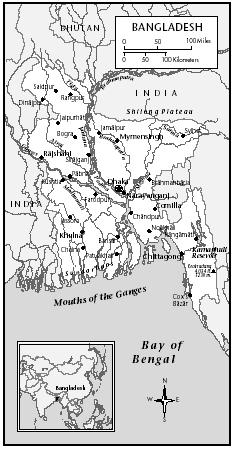
Bangladesh
and poetry, and the well educated. Cholit basha is the spoken
vernacular,
the language of the great majority of Bengalis. Cholit basha is
the medium
by which the great majority of people communicate in a country in
which 50
percent of men and 26 percent of women are literate. There are
also small
usage variations between Muslims and Hindus, along with minor
vocabulary
differences.
Symbolism.
The most important symbol of national identity is the Bangla
language.
The flag is a dark green rectangle with a red circle just left of
center.
Green symbolizes the trees and fields of the countryside; red
represents
the rising sun and the blood spilled in the 1971 war for
liberation. The
national anthem was taken from a poem by Nobel laureate
Rabindranath
Tagore and links a love of the natural realm and land with the
national
identity.
Since independence in 1971, the national identity has evolved.
Islamic
religious identity has become an increasingly important element in
the
national dialogue. Many Islamic holy days are nationally
celebrated, and
Islam pervades public space and the media.
Ethnic Relations.
The most significant social divide is between Muslims and Hindus.
In 1947
millions of Hindus moved west into West Bengal, while millions of
Muslims
moved east into the newly created East Pakistan. Violence occurred
as the
columns of people moved past each other. Today, in most sections
of the
country, Hindus and Muslims live peacefully in adjacent areas and
are
connected by their economic roles and structures. Both groups view
themselves as members of the same culture.
From 1976 to 1998 there was sustained cultural conflict over the
control
of the southeastern Chittagong Hill Tracts. That area is home to a
number
of tribal groups that resisted the movement of Bangladeshi Muslims
into
their territory. In 1998, a peace accord granted those groups a
degree of
autonomy and self-governance. These tribal groups still do not
identify
themselves with the national culture.
URBANIZATION, ARCHITECTURE, AND THE
USE OF
SPACE
Bangladesh is still primarily a rural culture, and the
gram
or village is an important spatial and cultural concept even for
residents of the major cities. Most people identify with a natal
or
ancestral village in the countryside.
Houses in villages are commonly rectangular, and are dried mud,
bamboo, or
red brick structures with thatch roofs. Many are built on top of
earthen
or wooden platforms to keep them above the flood line. Houses have
little
interior decoration, and wall space is reserved for storage.
Furniture is
minimal, often consisting only of low stools. People sleep on thin
bamboo
mats. Houses have verandas in the front, and much of daily life
takes
place under their eaves rather than indoors. A separate smaller
mud or
bamboo structure serves as a kitchen (
rana ghor
), but during the dry season many women construct hearths and cook
in the
household courtyard. Rural houses are simple and functional, but
are not
generally considered aesthetic showcases.
The village household is a patrilineal extended compound linked to
a pond
used for daily household needs, a nearby river that provides fish,
trees
that provide fruit (mango and jackfruit especially), and rice
fields. The
village and the household not
only embody important natural motifs but serve as the locus of
ancestral
family identity. Urban dwellers try to make at least one trip per
year to
"their village."
Architectural styles in the cities show numerous historical
influences,
including Moghul and Islamic motifs with curved arches, windows,
and
minarets, and square British colonial wood and concrete
construction. The
National Parliament building (Shongshad Bhabon) in Dhaka, designed
by the
American architect Louis Kahn, reflects a synthesis of western
modernity
and curved Islamic-influenced spaces. The National Monument in
Savar, a
wide-based spire that becomes narrower as it rises, is the symbol
of the
country's liberation.
Because of the population density, space is at a premium. People
of the
same sex interact closely, and touching is common. On public
transportation strangers often are pressed together for long
periods. In
public spaces, women are constrained in their movements and they
rarely
enter the public sphere unaccompanied. Men are much more free in
their
movement. The rules regarding the gender differential in the use
of public
space are less closely adhered to in urban areas than in rural
areas.
FOOD AND
ECONOMY
Food in Daily Life.
Rice and fish are the foundation of the diet; a day without a
meal with
rice is nearly inconceivable. Fish, meats, poultry, and vegetables
are
cooked in spicy curry (
torkari
) sauces that incorporate cumin, coriander, cloves, cinnamon,
garlic, and
other spices. Muslims do not consume pork and Hindus do not
consume beef.
Increasingly common is the preparation of
ruti,
a whole wheat circular flatbread, in the morning, which is eaten
with
curries from the night before. Also important to the diet is
dal,
a thin soup based on ground lentils, chickpeas, or other legumes
that is
poured over rice. A sweet homemade yogurt commonly finishes a
meal. A
typical meal consists of a large bowl of rice to which is added
small
portions of fish and vegetable curries. Breakfast is the meal that
varies
the most, being rice- or bread-based. A favorite breakfast dish is
panthabhat,
leftover cold rice in water or milk mixed with
gur
(date palm sugar). Food is eaten with the right hand by mixing
the curry
into the rice and then gathering portions with the fingertips. In
city
restaurants that cater to foreigners, people may use silverware.
Three meals are consumed daily. Water is the most common beverage.
Before
the meal, the right hand is washed with water above the eating
bowl. With
the clean knuckles of the right hand the interior of the bowl is
rubbed,
the water is discarded, and the bowl is filled with food. After
the meal,
one washes the right hand again, holding it over the emptied bowl.
Snacks include fruits such as banana, mango, and jackfruit, as
well as
puffed rice and small fried food items. For many men, especially
in
urbanized regions and bazaars, no day is complete without a cup of
sweet
tea with milk at a small tea stall, sometimes accompanied by
confections.
Food Customs at Ceremonial Occasions.
At weddings and on important holidays, food plays an important
role. At
holiday or formal functions, guests are encouraged to eat to their
capacity. At weddings, a common food is
biryani,
a rice dish with lamb or beef and a blend of spices, particularly
saffron. On special occasions, the rice used is one of the finer,
thinner-grained types. If biryani is not eaten, a complete
multicourse
meal is served: foods are brought out sequentially and added to
one's rice bowl after the previous course is finished. A complete
dinner may include chicken, fish, vegetable, goat, or beef curries
and
dal. The final bit of rice is finished with yogurt (
doi
).
On other important occasions, such as the Eid holidays, a goat or
cow is
slaughtered on the premises and curries are prepared from the
fresh meat.
Some of the meat is given to relatives and to the poor.
Basic Economy.
With a per capita gross national product (GNP) of $350 and an
overall GNP
of $44 billion, Bangladesh is one of the poorest countries in the
world.
The only significant natural resource is natural gas.
Approximately 75 percent of the workforce is involved in
agriculture, and
15 percent and 10 percent are employed in the service and
industrial
sectors, respectively. Bangladesh has been characterized as a
nation of
small, subsistence-based farmers, and nearly all people in rural
areas are
involved in the production or processing of agricultural goods.
The
majority of the rural population engages in agricultural
production,
primarily of rice, jute, pulses, wheat, and some vegetables.
Virtually all
agricultural output is consumed within the country, and grain must
be
imported. The large population places heavy demands on the
food-producing
sectors of the economy. The majority of the labor involved in food
production is human- and animal-based. Relatively little
agricultural
export takes place.
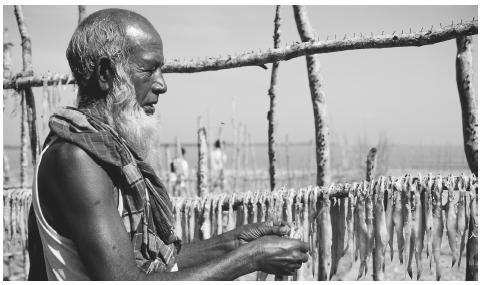
A Bangladeshi man hanging fish to dry in the sun in
Sunderbans.
Bangladesh topography is predominantly a low-lying
floodplain.
In the countryside, typically about ten villages are linked in a
market
system that centers on a bazaar occurring at least once per week.
On
bazaar days, villagers bring in agricultural produce or crafts
such as
water pots to sell to town and city agents. Farmers then visit
kiosks to
purchase spices, kerosene, soap, vegetables or fish, and salt.
Land Tenure and Property.
With a population density of more than two thousand per square
mile, land
tenure and property rights are critical aspects of survival. The
average
farm owner has less than three acres of land divided into a number
of
small plots scattered in different directions from the household.
Property
is sold only in cases of family emergency, since agricultural land
is the
primary means of survival. Ordinarily, among Muslims land is
inherited
equally by a household head's sons, despite Islamic laws that
specify shares for daughters and wives. Among Hindu farmers
inheritance
practices are similar. When agricultural land is partitioned, each
plot is
divided among a man's sons, ensuring that each one has a
geographically dispersed holding. The only sections of rural areas
that
are not privately owned are rivers and paths.
Commercial Activities.
In rural areas Hindus perform much of the traditional craft
production of
items for everyday life; caste groups include weavers, potters,
iron and
gold smiths, and carpenters. Some of these groups have been
greatly
reduced in number, particularly weavers, who have been replaced by
ready-made clothing produced primarily in Dhaka.
Agriculture accounts for 25 percent of GDP. The major crops are
rice,
jute, wheat, tea, sugarcane, and vegetables.
Major Industries.
In recent years industrial growth has occurred primarily in the
garment
and textile industries. Jute processing and jute product
fabrication
remain major industries. Overall, industry accounted for about 28
percent
of gross domestic product (GDP) in 1998.
Trade.
Exports totaled $4.4 billion in 1996, with the United States
consuming
one-third of those exports. Primary export markets are for jute
(used in
carpet backing, burlap, and rope), fish, garments, and textiles.
Imports
totaled $7.1 billion and largely consisted of capital goods,
grains,
petroleum, and chemicals. The country relies on an annual inflow
of at
least $1 billion from international sources, not including the
humanitarian aid that is part of the national economic system.
Agriculture
accounted for about 25 percent of the GDP in 1998.
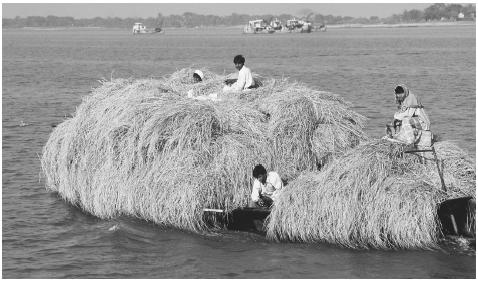
Transporting straw on the Ganges River Delta. The majority
of
Bangladeshi, about 75 percent, are agricultural workers.
Division of Labor.
The division of labor is based on age and education. Young
children are
economically productive in rural areas, hauling water, watching
animals,
and helping with postharvest processing. The primary agricultural
tasks,
however, are performed by men. Education allows an individual to
seek
employment outside the agricultural sector, although the
opportunities for
educated young men in rural areas are extremely limited. A service
or
industry job often goes to the individual who can offer the
highest bribe
to company officials.
SOCIAL
STRATIFICATION
Classes and Castes.
The Muslim class system is similar to a caste structure. The
ashraf
is a small upperclass of old-money descendants of early Muslim
officials
and merchants whose roots are in Afghanistan, Turkey, and Iran.
Some
ashraf families trace their lineage to the Prophet Mohammed. The
rest of
the population is conceived of as the indigenous majority
atraf.
This distinction mirrors the Hindu separation between the Brahman
and
those in lower castes. While both Muslim and Hindu categories are
recognized by educated people, the vast majority of citizens
envision
class in a more localized, rural context.
In rural areas, class is linked to the amount of land owned,
occupation,
and education. A landowner with more than five acres is at the top
of the
socioeconomic scale, and small subsistence farmers are in the
middle. At
the bottom of the scale are the landless rural households that
account for
about 30 percent of the rural population. Landowning status
reflects
socioeconomic class position in rural areas, although occupation
and
education also play a role. The most highly educated people hold
positions
requiring literacy and mathematical skills, such as in banks and
government offices, and are generally accorded a higher status
than are
farmers. Small businessmen may earn as much as those who have jobs
requiring an education but have a lower social status.
Hindu castes also play a role in the rural economy. Hindu groups
are
involved in the hereditary occupations that fill the economic
niches that
support a farming-based economy. Small numbers of higher caste
groups have
remained in the country, and some of those people are large
landowners,
businessmen, and service providers.
In urban areas the great majority of people are laborers. There is
a
middle class of small businessmen and midlevel office workers, and
above
this is
an emerging entrepreneurial group and upper-level service
workers.
Symbols of Social Stratification.
One of the most obvious symbols of class status is dress. The
traditional
garment for men is the
lungi,
a cloth tube skirt that hangs to the ankles; for women, the
sari
is the norm. The lungi is worn by most men, except those who
consider
themselves to have high socioeconomic status, among whom pants and
shirt
are worn. Also indicative of high standing are loose white cotton
pajama
pants and a long white shirt. White dress among men symbolizes an
occupation that does not require physical labor. A man with high
standing
will not be seen physically carrying anything; that task is left
to an
assistant or laborer.
Saris
also serve as class markers, with elaborate and finely worked
cloth
symbolizing high status. Poverty is marked by the cheap, rough
green or
indigo cotton cloth saris of poor women. Gold jewelry indicates a
high
social standing among women.
A concrete-faced house and a ceramic tile roof provide evidence of
wealth.
An automobile is well beyond the means of most people, and a
motorcycle is
a sign of status. Color televisions, telephones, and electricity
are other
symbols associated with wealth.
NON GOVERNMENTAL
ORGANIZATIONS AND
OTHER
ASSOCIATIONS
The Grameen Bank created the popular microcredit practice, which
has given
the poor, especially poor women, access to credit. This model is
based on
creating small circles of people who know and can influence each
other to
pay back loans. When one member has repaid a loan, another member
of the
group becomes eligible to receive credit. Other nongovernmental
organizations include the Bangladesh Rural Advancement Committee,
Probashi, and Aat Din.
GENDER
ROLES AND
STATUSES
Division of Labor by Gender.
Women traditionally are in charge of household affairs and are
not
encouraged to move outside the immediate neighborhood
unaccompanied. Thus,
most women's economic and social lives revolve around the home,
children, and family. Islamic practice reserves prayer inside the
mosque
for males only; women practice religion within the home.
Bangladesh has
had two female prime ministers since 1991, both elected with
widespread
popular support, but women are not generally publicly active in
politics.
Men are expected to be the heads of their households and to work
outside
the home. Men often do the majority of the shopping, since that
requires
interaction in crowded markets. Men spend a lot of time
socializing with
other men outside the home.
The Relative Status of Women and Men.
The society is patriarchal in nearly every area of life, although
some
women have achieved significant positions of political power at
the
national level. For ordinary women, movement is confined,
education is
stressed less than it is for men, and authority is reserved for a
woman's father, older brother, and husband.
MARRIAGE
, FAMILY, AND
KINSHIP
Marriage.
Marriage is almost always an arranged affair and takes place when
the
parents, particularly the father, decide that a child should be
married.
Men marry typically around age twenty-five or older, and women
marry
between ages fifteen and twenty; thus the husband is usually at
least ten
years older than the wife. Muslims allow polygynous marriage, but
its
occurrence is rare and is dependent on a man's ability to support
multiple households.
A parent who decides that a child is ready to marry may contact
agencies,
go-betweens, relatives, and friends to find an appropriate mate.
Of
immediate concern are the status and characteristics of the
potential
in-law's family. Generally an equal match is sought in terms of
family economic status, educational background, and piousness. A
father
may allow his child to choose among five or six potential mates,
providing
the child with the relevant data on each candidate. It is
customary for
the child to rule out clearly unacceptable candidates, leaving a
slate of
candidates from which the father can choose. An arrangement
between two
families may be sealed with an agreement on a dowry and the types
of gifts
to be made to the groom. Among
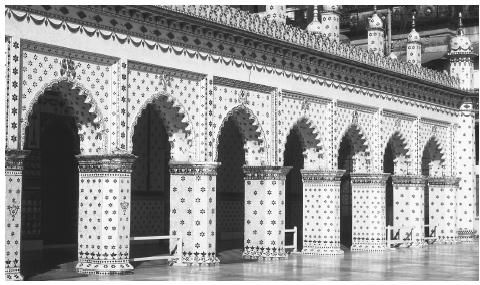
The Sitara (star) mosque in Dacca. Religion plays a
fundamental role
in society, and almost every village has a mosque.
the educated the dowry practice is no longer prevalent.
Divorce is a source of social stigma. A Muslim man may initiate a
divorce
by stating "I divorce you" three times, but very strong
family pressure ordinarily ensures that divorces do not occur. A
divorce
can be most difficult for the woman, who must return to her
parent's household.
Domestic Unit.
The most common unit is the patrilineally-related extended family
living
in a household called a
barhi.
A barhi is composed of a husband and wife, their unmarried
children, and
their adult sons with their wives and children. Grandparents also
may be
present, as well as patrilineally-related brothers, cousins,
nieces, and
nephews. The oldest man is the authority figure, although the
oldest woman
may exert considerable authority within the household. A barhi in
rural
areas is composed of three or four houses which face each other to
form a
square courtyard in which common tasks are done. Food supplies
often are
shared, and young couples must contribute their earnings to the
household
head. Cooking, however, often is done within the constituent
nuclear
family units.
Inheritance.
Islamic inheritance rules specify that a daughter should receive
one-half
the share of a son. However, this practice is rarely followed, and
upon a
household head's death, property is divided equally among his
sons.
Daughters may receive produce and gifts from their brothers when
they
visit as "compensation" for their lack of an inheritance. A
widow may receive a share of her husband's property, but this is
rare. Sons, however, are custom-bound to care for their mothers,
who
retain significant power over the rest of the household.
Kin Groups.
The patrilineal descent principle is important, and the lineage
is very
often localized within a geographic neighborhood in which it
constitutes a
majority. Lineage members can be called on in times of financial
crisis,
particularly when support is needed to settle local disputes.
Lineages do
not meet regularly or control group resources.
SOCIALIZATION
Infant Care.
Most women give birth in their natal households, to which they
return
when childbirth is near. A husband is sent a message when the
child is
born. Five or seven days after the birth the husband and his close
male
relatives visit the newborn, and a feast and ritual haircutting
take
place. The newborn is given an amulet that is tied around the
waist, its
eye sockets may be blackened with soot or makeup, and a small soot
mark is
applied to the infant's
forehead and the sole of the foot for protection against spirits.
Newborns and infants are seldom left unattended. Most infants are
in
constant contact with their mothers, other women, or the daughters
in the
household. Since almost all women breastfeed, infant and mother
sleep
within close reach. Infants' needs are attended to constantly; a
crying baby is given attention immediately.
Child Rearing and Education.
Children are raised within the extended family and learn early
that
individual desires are secondary to the needs of the family group.
Following orders is expected on the basis of age; an adult or
older
child's commands must be obeyed as a sign of respect. Child care
falls primarily to household women and their daughters. Boys have
more
latitude for movement outside the household.
Between ages five and ten, boys undergo a circumcision (
musulmani
), usually during the cool months. There is no comparable ritual
for
girls, and the menarche is not publicly marked.
Most children begin school at age five or six, and attendance
tends to
drop off as children become more productive within the household
(female)
and agricultural economy (male). About 75 percent of children
attend
primary school. The higher a family's socioeconomic status, the
more likely it is for both boys and girls to finish their primary
educations. Relatively few families can afford to send their
children to
college (about 17 percent), and even fewer children attend a
university.
Those who enter a university usually come from relatively well-off
families. While school attendance drops off overall as the grades
increase, females stop attending school earlier than do males.
Higher Education.
Great value is placed on higher education, and those who have
university
degrees and professional qualifications are accorded high status.
In rural
areas the opportunities for individuals with such experience are
limited;
thus, most educated people are concentrated in urban areas.
Bangladesh has a number of excellent universities in its largest
urban
areas that offer both undergraduate through post-graduate degrees.
The
most prominent universities, most of which are state supported,
include:
Dhaka University, Rajshahi University, Chittagong University,
Jahngirnagar
University, Bangladesh University of Engineering and Technology,
and
Bangladesh Agricultural University. Competition for university
admission
is intense (especially at Dhaka University) and admission is
dependent on
scores received on high school examinations held annually, as in
the
British system
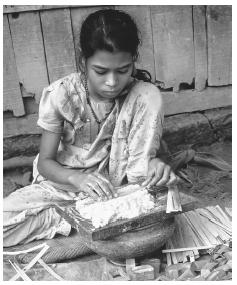
A young girl makes matchboxes in the slums of Khulna. There
is a
marked split between rich and poor in most of the country.
of education. University life in Bangladesh can be difficult. A
four-year
degree may actually require five to eight years to complete due to
frequent university closings. The student bodies and faculties of
universities are heavily politicized along national political
party lines.
Protests, strikes, and sporadic political party-based violence are
common,
as student groups play out national political agendas on their
campuses
and vie for members. Virtually every university student finds it
easier to
survive the system by becoming a member of the student wing of a
political
party.
While the universities are the scenes of political struggle, they
are also
centers of intellectual and cultural creativity. Students may
obtain
excellent training in all fields, including the arts, law,
medicine, and
engineering. Universities are also somewhat like islands where
some of the
ordinary rules of social interaction are relaxed. For example,
male– female interaction on campuses is more open and less
monitored than in society as a whole. Dance and theater
presentations are
common, as are academic debates.
ETIQUETTE
Personal interaction is initiated with the greeting
Assalam Waleykum
("peace be with you"), to which the required response is,
Waleykum Assalam
("and with you"). Among Hindus, the correct greeting is
Nomoshkar,
as the hands are brought together under the chin. Men may shake
hands if
they are of equal status but do not grasp hands firmly. Respect is
expressed after a handshake by placing the right hand over the
heart. Men
and women do not shake hands with each other. In same-sex
conversation,
touching is common and individuals may stand or sit very close.
The closer
individuals are in terms of status, the closer their spatial
interaction
is. Leave-taking is sealed with the phrase
Khoda Hafez.
Differences in age and status are marked through language
conventions.
Individuals with higher status are not addressed by personal name;
instead, a title or kinship term is used.
Visitors are always asked to sit, and if no chairs are available, a
low
stool or a bamboo mat is provided. It is considered improper for a
visitor
to sit on the floor or ground. It is incumbent on the host to
offer guests
something to eat.
In crowded public places that provide services, such as train
stations,
the post office, or bazaars, queuing is not practiced and
receiving
service is dependent on pushing and maintaining one's place within
the throng. Open staring is not considered impolite.
RELIGION
Religious Beliefs.
The symbols and sounds of Islam, such as the call to prayer,
punctuate
daily life. Bangladeshis conceptualize themselves and others
fundamentally
through their religious heritage. For example, the nationality of
foreigners is considered secondary to their religious identity.
Islam is a part of everyday life in all parts of the country, and
nearly
every village has at least a small mosque and an imam (cleric).
Prayer is
supposed to be performed five times daily, but only the committed
uphold
that standard. Friday afternoon prayer is often the only time that
mosques
become crowded.
Throughout the country there is a belief in spirits that inhabit
natural
spaces such as trees, hollows, and riverbanks. These beliefs are
derided
by Islamic religious authorities.
Hinduism encompasses an array of deities, including Krishna, Ram,
Durga,
Kali, and Ganesh. Bangladeshi Hindus pay particular attention to
the
female goddess Durga, and rituals devoted to her are among the
most widely
celebrated.
Religious Practitioners.
The imam is associated with a mosque and is an important person
in both
rural and urban society, leading a group of followers. The imam's
power is based on his knowledge of the Koran and memorization of
phrases
in Arabic. Relatively few imams understand Arabic in the spoken or
written
form. An imam's power is based on his ability to persuade groups
of
men to act in conjunction with Islamic rules. In many villages the
imam is
believed to have access to the supernatural, with the ability to
write
charms that protect individuals from evil spirits, imbue liquids
with holy
healing properties, or ward off or reverse of bad luck.
Brahman priests perform rituals for the Hindu community during the
major
festivals when offerings are made but also in daily acts of
worship. They
are respected, but Hinduism does not have the codified
hierarchical
structure of Islam. Thus, a Brahman priest may not have a position
of
leadership outside his religious duties.
Rituals and Holy Places.
The primary Islamic holidays in Bangladesh include:
Eid-ul-Azha
(the tenth day of the Muslim month
Zilhaj
), in which a goat or cow is sacrificed in honor of Allah;
Shob-i-Barat
(the fourteenth or fifteenth day of
Shaban
), when Allah records an individual's future for the rest of the
year;
Ramadan
(the month
Ramzan
), a month-long period of fasting between dawn and dusk;
Eid-ul-Fitr
(the first day of the month
Shawal,
following the end of
Ramzan
), characterized by alms giving to the poor; and
Shob-i-Meraz
(the twenty-seventh day of
Rajab
), which commemorates the night when Mohammed ascended to heaven.
Islamic
holidays are publicly celebrated in afternoon prayers at mosques
and
outdoor open areas, where many men assemble and move through their
prayers
in unison.
Among the most important Hindu celebrations are
Saraswati Puja
(February), dedicated to the deity Saraswati, who takes the form
of a
swan. She is the patron of learning, and propitiating her is
important for
students.
Durga Puja
Kali Puja
(November) is also called the Festival of Lights and honors Kali,
a
female deity who has the power to give and take away life. Candles
are lit
in and around homes.
(October) pays homage to the female warrior goddess Durga, who
has ten
arms, carries a sword, and rides a lion. After a nine-day
festival, images
of Durga and her associates are placed in a procession and set
into a
river.
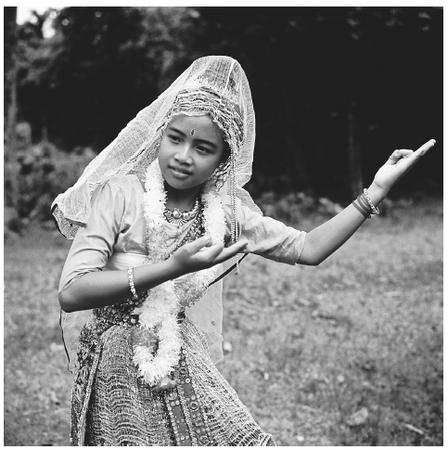
A young Bengali woman performs a traditional Manipuri dance.
Almost
all traditional dancers are women.
Other Hindu and Islamic rituals are celebrated in villages and
neighborhoods and are dependent on important family or local
traditions.
Celebrations take place at many local shrines and temples.
Death and the Afterlife.
Muslims believe that after death the soul is judged and moves to
heaven
or hell. Funerals require that the body be washed, the nostrils
and ears
be plugged with cotton or cloth, and the body be wrapped in a
white
shroud. The body is buried or entombed in a brick or concrete
structure.
In Hinduism, reincarnation is expected and one's actions
throughout
life determine one's future lives. As the family mourns and close
relatives shave their heads, the body is transported to the
funeral
ghat
(bank along a river), where prayers are recited. The body is to
be placed
on a pyre and cremated, and the ashes are thrown into the river.
MEDICINE AND
HEALTH
CARE
The pluralistic health care system includes healers such as
physicians,
nonprofessionally trained doctors, Aryuvedic practitioners,
homeopaths,
fakirs,
and naturopaths. In rural areas, for non-life-threatening acute
conditions, the type of healer consulted depends largely on local
reputation. In many places, the patient consults a homeopath or a
nonprofessional doctor who is familiar with local remedies as well
as
modern medical practices. Professional physicians are consulted by
the
educated and by those who have not received relief from other
sources.
Commonly, people pursue alternative treatments simultaneously,
visiting a
fakir for an amulet, an imam for blessed oil, and a physician for
medicine.
A nationally run system of public hospitals provides free service.
However, prescriptions and some medical supplies are the
responsibility of
patients and their families.
Aryuvedic beliefs based on humoral theories are common among both
Hindus
and Muslims. These beliefs are commonly expressed through the
categorization of the inherent hot or cold properties of foods. An
imbalance in hot or cold food intake is believed to lead to
sickness.
Health is restored when this imbalance is counteracted through
dietary
means.
SECULAR
CELEBRATIONS
Ekushee
(21 February), also called
Shaheed Dibash,
is the National Day of Martyrs commemorating those who died
defending the
Bangla language in 1952. Political speeches are held, and a
memorial
service takes place at the
Shaheed Minar
(Martyr's Monument) in Dhaka.
Shadheenata Dibash,
or Independence Day (26 March), marks the day when Bangladesh
declared
itself separate from Pakistan. The event is marked with military
parades
and political speeches.
Poila Boishakh,
the Bengali New Year, is celebrated on the first day of the month
of
Boishakh
(generally in April). Poetry readings and musical events take
place. May
Day (1 May) celebrates labor and workers with speeches and
cultural
events.
Bijoy Dibosh,
or Victory Day (16 December), commemorates the day in 1971 when
Pakistani
forces surrendered to a joint Bangladeshi–Indian force. Cultural
and political events are held.
T
HE
ARTS AND
HUMANITIES
Support for the Arts.
Artists are largely self-supporting. The Bangla Academy in Dhaka
provides
support for some artists, particularly writers and poets. Many
artists
sell aesthetic works that have utilitarian functions.
Literature.
Most people, regardless of their degree of literacy, can recite
more than
one poem with dramatic inflection. Best known are the works of the
two
poet–heroes of the region: Rabindranath Tagore and Kazi Nurul
Islam. Tagore was awarded the Nobel Prize for Literature in 1913.
Although
from West Bengal, he is respected as a Bengali who championed the
preservation of Bangla language and culture. His poem "Golden
Bengal" was adopted as the national anthem.
The most famous contemporary writer is Taslima Nasreen, whose
novellas and
essays question the Islamic justification for the customary
treatment of
women. Conservative religious authorities have tried to have her
arrested
and have called for her death for blasphemy. She lives in exile.
Graphic Arts.
Most graphic arts fall within the domain of traditional
production by
Hindu caste groups. The most pervasive art form throughout the
country is
pottery, including water jugs and bowls of red clay, often with a
red slip
and incising. Some Hindu sculptors produce brightly painted works
depicting Durga and other deities. Drawing and painting are most
visible
on the backs of rickshaws and the wooden sides of trucks.
Performance Arts.
Bengali music encompasses a number of traditions and mirrors some
of the
country's poetry. The most common instruments are the harmonium,
the tabla, and the sitar. Generally, classical musicians are adept
at the
rhythms and melodic properties associated with Hindu and Urdu
devotional
music. More popular today are the secular male–female duets that
accompany Bengali and Hindi films. These songs are rooted in the
classical
tradition but have a freer contemporary melodic structure.
Traditional
dance is characterized by a rural thematic element with particular
hand,
foot, and head movements. Dance is virtually a female-only
enterprise.
Plays are traditionally an important part of village life, and
traveling
shows stop throughout the countryside. Television dramas portray
family
relationships, love, and economic advantage and disadvantage.
Plays in the
cities, particularly in Dhaka, are attended by the educated young.
T
HE
STATE OF THE
PHYSICAL AND
SOCIALS
CIENCES
Dhaka University offers courses in most academic disciplines.
Sciences
such as physics and chemistry have very good programs, although
there is a
lack of up-to-date laboratories and equipment. In the social
sciences, the
field of economics is particularly strong, along with
anthropology,
sociology, and
political science. Many top students in the physical and social
sciences
study abroad, especially in the United States and Europe. The top
engineering program is at the Bangladesh University of Engineering
and
Technology. Electrical, ocean/naval, civil, and mechanical
engineering
have very good programs. Education in computer engineering is
improving
rapidly.
|











